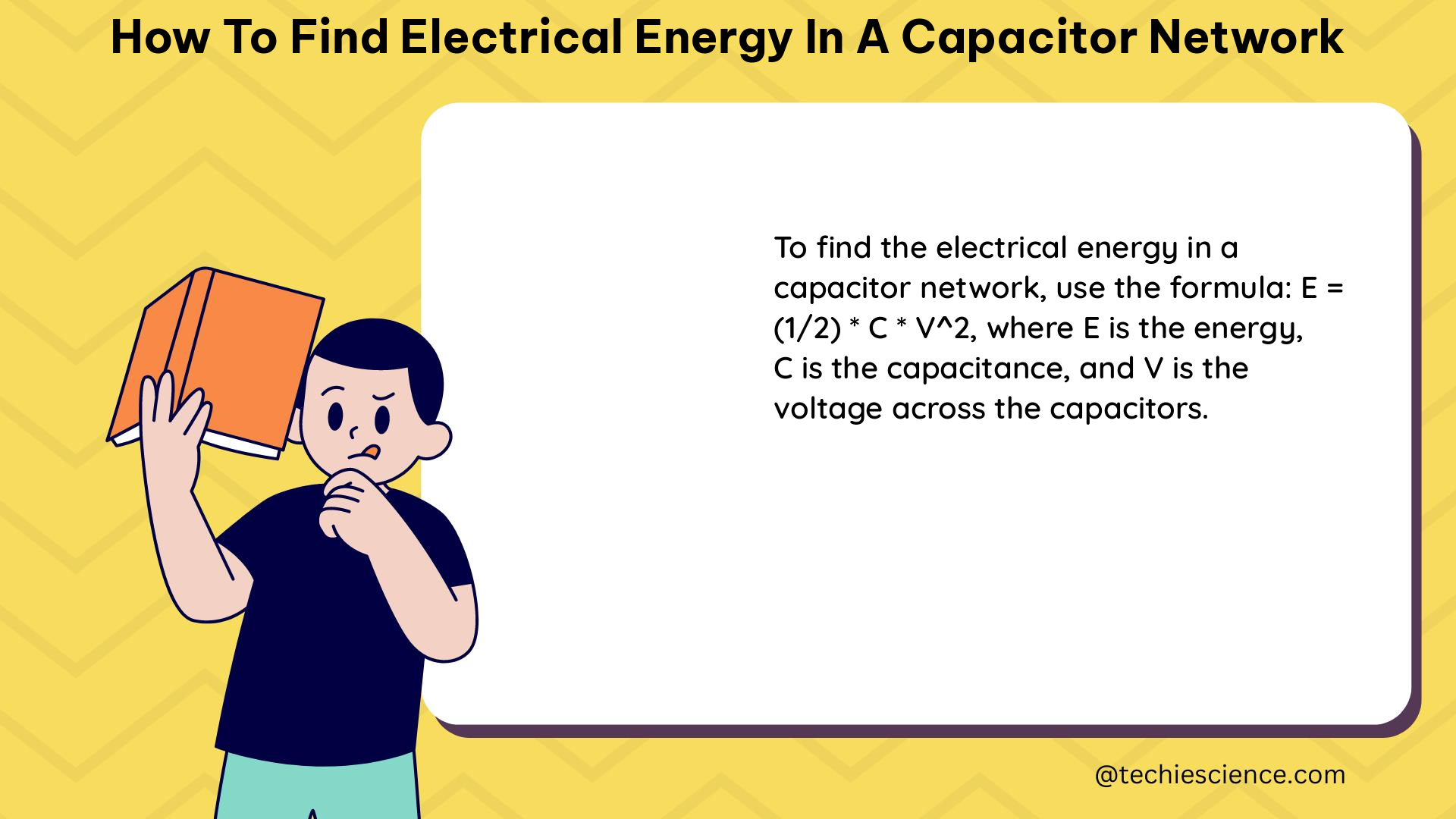The electrical energy stored in a capacitor network is a crucial parameter in various electrical and electronic applications, from power supply systems to energy storage devices. This comprehensive guide will provide you with a deep understanding of the principles, formulas, and practical examples to help you accurately determine the electrical energy in a capacitor network.
Understanding Capacitance and Voltage
The fundamental relationship between the electrical energy stored in a capacitor and its capacitance and voltage is given by the formula:
E = 0.5 * C * V^2
Where:
– E is the electrical energy stored in the capacitor, measured in joules (J)
– C is the capacitance of the capacitor, measured in farads (F)
– V is the voltage across the capacitor, measured in volts (V)
This formula is the foundation for calculating the electrical energy in a capacitor network, as it allows you to determine the energy stored in each individual capacitor.
Capacitor Networks in Series

When capacitors are connected in series, the total electrical energy stored in the network is the sum of the energy stored in each individual capacitor. The formula for the total energy in a series capacitor network is:
E_total = 0.5 * C1 * V1^2 + 0.5 * C2 * V2^2 + ... + 0.5 * Cn * Vn^2
Where:
– E_total is the total electrical energy stored in the capacitor network
– C1, C2, …, Cn are the capacitances of the individual capacitors
– V1, V2, …, Vn are the voltages across the individual capacitors
To calculate the total energy, you need to know the capacitance and voltage of each capacitor in the series network.
Capacitor Networks in Parallel
When capacitors are connected in parallel, the total electrical energy stored in the network is the sum of the energy stored in each individual capacitor. The formula for the total energy in a parallel capacitor network is:
E_total = 0.5 * (C1 + C2 + ... + Cn) * V^2
Where:
– E_total is the total electrical energy stored in the capacitor network
– C1, C2, …, Cn are the capacitances of the individual capacitors
– V is the voltage across the parallel combination of capacitors
In this case, the voltage is the same across all the capacitors in the parallel network.
Examples and Numerical Problems
Let’s consider some examples to illustrate the application of these formulas.
Example 1: Series Capacitor Network
Suppose you have a series capacitor network with the following parameters:
– Capacitor 1: C1 = 5 F, V1 = 10 V
– Capacitor 2: C2 = 10 F, V2 = 20 V
To calculate the total electrical energy stored in the network, we use the formula:
E_total = 0.5 * C1 * V1^2 + 0.5 * C2 * V2^2
E_total = 0.5 * 5 * 10^2 + 0.5 * 10 * 20^2
E_total = 250 J + 2000 J
E_total = 2250 J
Example 2: Parallel Capacitor Network
Consider a parallel capacitor network with the following parameters:
– Capacitor 1: C1 = 5 F
– Capacitor 2: C2 = 10 F
– Voltage across the network: V = 20 V
To calculate the total electrical energy stored in the network, we use the formula:
E_total = 0.5 * (C1 + C2) * V^2
E_total = 0.5 * (5 + 10) * 20^2
E_total = 0.5 * 15 * 400
E_total = 3000 J
Numerical Problems
-
A capacitor network consists of three capacitors in series:
C1 = 2 F,C2 = 4 F, andC3 = 6 F. The voltage across the network isV = 50 V. Calculate the total electrical energy stored in the network. -
A parallel capacitor network has four capacitors with the following values:
C1 = 10 F,C2 = 15 F,C3 = 20 F, andC4 = 25 F. The voltage across the network isV = 30 V. Determine the total electrical energy stored in the network. -
A series-parallel capacitor network has the following parameters:
- Series capacitors:
C1 = 5 F,C2 = 10 F - Parallel capacitors:
C3 = 3 F,C4 = 7 F - Voltage across the network:
V = 40 V
Calculate the total electrical energy stored in the network.
By solving these numerical problems, you can further develop your understanding of how to calculate the electrical energy in various capacitor network configurations.
Conclusion
In this comprehensive guide, we have explored the fundamental principles, formulas, and practical examples to help you determine the electrical energy stored in a capacitor network. By understanding the relationships between capacitance, voltage, and energy, as well as the specific calculations for series and parallel capacitor networks, you can now confidently analyze and calculate the electrical energy in a wide range of capacitor network scenarios.
References
- University Physics Volume 2 – OpenStax: https://openstax.org/books/university-physics-volume-2/pages/8-3-energy-stored-in-a-capacitor
- How To Calculate The Energy Stored In a Capacitor – YouTube: https://www.youtube.com/watch?v=PTyB6_Kt_5A
- Energy Stored in Capacitors – Lumen Learning: https://courses.lumenlearning.com/suny-physics/chapter/19-7-energy-stored-in-capacitors/
- Energy Stored and Electric Field in Capacitor – SlideShare: https://www.slideshare.net/slideshow/energy-stored-and-electric-field-in-capacitor/189606833
- How to Calculate the Energy Stored in a Charged Capacitor – Study.com: https://study.com/skill/learn/how-to-calculate-the-energy-stored-in-a-charged-capacitor-explanation.html

The lambdageeks.com Core SME Team is a group of experienced subject matter experts from diverse scientific and technical fields including Physics, Chemistry, Technology,Electronics & Electrical Engineering, Automotive, Mechanical Engineering. Our team collaborates to create high-quality, well-researched articles on a wide range of science and technology topics for the lambdageeks.com website.
All Our Senior SME are having more than 7 Years of experience in the respective fields . They are either Working Industry Professionals or assocaited With different Universities. Refer Our Authors Page to get to know About our Core SMEs.